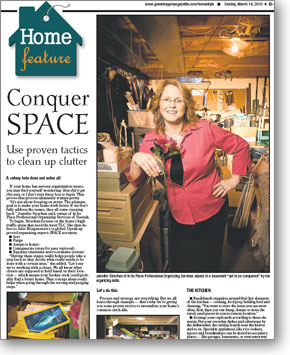
A Cutesy Tote Does Not Solve All
If your home has serious organization issues, you may find yourself wondering: How did it get this way, or I don’t even know how to begin. This proves that process ultimately trumps pretty. “It’s not about focusing on pretty. The ultimate goal is to make your home work better. If we don’t fully address the issues, they all come creeping back.” Jennifer Strachan said, owner of In Its Place Professional Organizing Services of Neenah. To begin, Strachan focuses on the home’s high traffic areas that need the most TLC. She then defers to Julie Morgenstern’s (a global, Oprah-approved organizing expert) SPACE acronym:
- Sort
- Purge
- Assign (a home)
- Containerize (store for easy retrieval)
- Equalize (maintain and re-evaluate system)
“Having these stages really helps people take a step back as they decide what really needs to be done with a certain area,” she added. “Let’s say we’re working with a closet. We all know what closets are supposed to hold based on their location— which means your hockey stick could probably find a better home. That concept alone really helps when going through the sorting and purging steps.”
It’s All About Making Decisions
In order for anyone to stick to a home organization plan, it needs to be realistic and intuitive. As the owner of Organizing Unlimited in Menasha, Sheryl Ruedebusch focuses on the overall vision of a room or space, followed by an assessment of the current function and, lastly, an action plan. She calls this the CDR, or Creating Desired Results, method. “I’ve noticed that people tend to get hung up on clichés or what they see on TV; decluttering does not mean you’ve got to throw out everything that you haven’t used,” Ruedebusch said. “Tome, clutter is defined by postponed decisions. And the CDR method helps you make sense of those decisions as you put things where they need to go.”
Let’s Do This
Process and strategy are everything. But we all learn through example — that’s why we’re giving you some proven tactics to streamline your home’s common catch-alls.
THE CLOSET
Experts reason that we wear 20 percent of the clothing in our wardrobe 80 percent of the time. “With the exception of eveningwear and classic outfits, look to donate the clothes you haven’t worn in years,” Ruedebusch said. “We’re all reluctant to get rid of clothing. But think of the pleasure donating can bring to someone else.”
Recycle all wire hangers, and opt for a uniform clothes-specific assortment. (Bed, Bath & Beyond’s swivel hangers for skirts and dresses are great.)
Use every square inch of space. Hang shoe racks on the back of the door. Classic belt hangers with multiple hooks are also a good solution for hanging camisoles, bras or scarves.
Assemble a few key outfits on hangers including accessories. Not only does this save on some hanger and hook space — it makes last-minute packing and outfit changes a snap.
Strachan recommends thinking long-term when it comes to closet organization. “I had a client that changed an entryway closet into a pantry, so they had no place to hang their coats. They reasoned, ‘Oh, we can put the coats in the front door closet.’ Did they? No. That’s why I try to be realistic by asking my clients: Is this something you’ll stick to after the honeymoon period, after a long, hard day?”
THE KITCHEN
Ruedebusch organizes around four key elements of the kitchen—cooking, food prep, holding food and cleaning. “You want to store the items you use most often, first; then you can dump, donate or store the rarely used pieces in a more remote location.”
Arrange your cupboards according to these elements. Put your everyday dishes and silverware by the dishwasher, the cutting boards near the knives and so on. Specialty appliances, like rice cookers, juicers and breadmakers can be stored in secondary places—like garages, basements, or even entryway benches.
For those who are always hunting for the oregano: Try alphabetizing your herbs and spices, and arrange them in a cabinet rack.
Plastic drawer trays are your best friend, and often come cheap from dollar stores. Pickup a few different sizes to streamline your large utensil drawers.
Organize the food in your fridge by type: drinks and small containers on the top rack, leftovers/prepared meals on the middle and whole/unprepared goods on the bottom. Strachan also orders her deep freezer according to food and prep type. “I don’t necessarily consider it efficient. It’s more like me being lazy, and not wanting to sort things over and over again.”
THE HOME OFFICE
Whether you dig bankers boxes, desk drawers or a covered bin, filing systems really are indispensible —and should be divided into two categories: important documents for later reference (taxes, investment information, paid documents) and documents that need tending to (bills and invitations).
Rather than housing a to-be-burned-in-the-fire-pit box for confidential papers, invest in a paper shredder.
Binders are great for organizing special projects, committee work and warranty information for autos, electronics and appliances.
Instead of going crazy with Post-it reminders, organize an office command center—complete with a bulletin board and dry-erase board. This can absorb any and all paperwork you might have hanging on the refrigerator as well.
STORY BY MORGAN L. BLOOHM
for the Green Bay Press Gazette
PHOTOS BY MATTHEW ROBINSON


